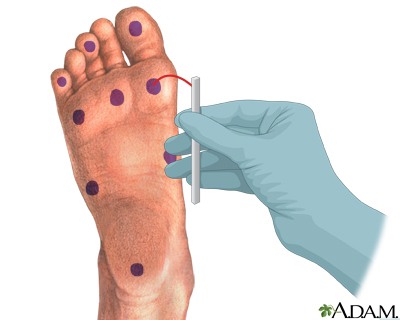Diabetes tests and checkups
Description
People who take control of their own diabetes care by eating healthy foods, living an active lifestyle, and taking medicines as prescribed often have good control of their blood sugar levels. Still, regular health checkups and tests are needed. These visits give you a chance to:
- Ask your health care provider questions
- Learn more about your diabetes and what you can do to keep your blood sugar in your target range
- Make sure you are taking your medicines the right way
Alternative Names
Routine diabetes tests; Diabetes - prevention
See Your Doctor
See your diabetes provider every 3 to 6 months. During this visit, your provider should check your:
- Blood pressure
- Weight
- Feet
See your dentist every 6 months, also.
If you are taking insulin, your provider will also examine your skin to look for signs of reactions to insulin at your injection sites. These may be hard areas or areas where fat under the skin has formed a lump.
Your provider may also check your abdomen for signs of an enlarged liver.
Eye Exams
An eye doctor should check your eyes every year. See an eye doctor who takes care of people with diabetes.
If you have eye problems because of diabetes, you will probably see your eye doctor more often.
Foot Exams
Your provider should check the pulses in your feet and your reflexes at least once a year. Your provider should also look for:
- Calluses
- Infections
- Sores
- Thick toenails
- Loss of feeling anywhere in your feet (peripheral neuropathy), done with a tool called a monofilament
If you have had foot ulcers before, see your provider every 3 to 6 months. It is always a good idea to ask your provider to check your feet.
Hemoglobin A1C Tests
An A1C lab test shows how well you are controlling your blood sugar levels over a 3-month period.
The normal level is less than 5.7%. Most people with diabetes should aim for an A1C of less than 7%. Some people have a higher target. Your doctor will help decide what your target should be.
Higher A1C numbers mean that your blood sugar is higher and that you may be more likely to have complications from your diabetes.
Patient Education Video: HbA1c
Cholesterol
A cholesterol profile test measures cholesterol and triglycerides in your blood. You should have this kind of test in the morning, after not eating since the night before.
Adults with type 2 diabetes should have this test at least every 5 years. People age 40 or over with high cholesterol or on medicines to control their cholesterol may have this test more often.
Blood Pressure
Blood pressure should be measured at every visit. Talk to your provider about what your blood pressure goal should be.
Kidney Tests
Once a year, you should have a urine test that looks for a protein called albumin.
Your doctor will also have you take a blood test every year that measures how well your kidneys work.
Gallery

References
American Diabetes Association. 4. Comprehensive medical evaluation and assessment of comorbidities: standards of medical care in diabetes-2022. Diabetes Care. 2022;45(Suppl 1):S46-S59. PMID: 34964869 pubmed.ncbi.nlm.nih.gov/34964869/.
Brownlee M, Aiello LP, Sun JK, et al. Complications of diabetes mellitus. In: Melmed S, Auchus RJ, Goldfine AB, Koenig RJ, Rosen CJ, eds. Williams Textbook of Endocrinology. 14th ed. Philadelphia, PA: Elsevier; 2020:chap 37.
Centers for Disease Control and Prevention website. Your diabetes care schedule. www.cdc.gov/diabetes/managing/care-schedule.html. Updated May 25, 2021. Accessed August 26, 2022.